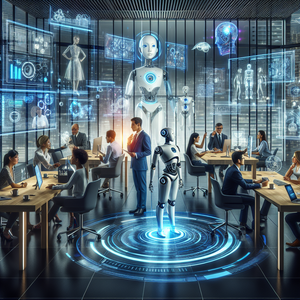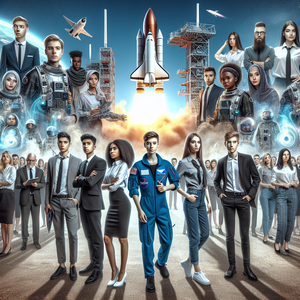The AI Co-Pilot Revolution in Space Engineering

AI has been gradually making its way into space systems engineering over the past decade. Initially, its role was largely supportive—automating data analysis, assisting with simulations, or providing insights from telemetry data. However, as AI technologies have advanced, they are now stepping into more active, decision-making roles. These AI "co-pilots" are no longer merely tools; they act as collaborators capable of running complex simulations, diagnosing anomalies, and even innovating designs. One key area where AI has transformed the engineering landscape is in system simulation. Traditionally, spacecraft engineers relied on intricate models to analyze orbital dynamics, thermal stress, or propulsion efficiency. These simulations, while effective, often required significant computational resources and weeks or months of work. Today, AI-powered algorithms are enabling real-time simulations, significantly reducing time and effort while improving accuracy. For example, the European Space Agency (ESA) recently used machine learning algorithms to optimize a communication satellite’s design. By simulating thousands of configurations, AI identified a solution that reduced the satellite’s weight by 15% and improved its power efficiency by 10%—a process that would have taken months using traditional methods.
Anomaly Detection: AI as the Ultimate Watchdog
One of the most critical responsibilities of space systems engineers is detecting and resolving anomalies in spacecraft systems. Anomaly detection is no small feat. Spacecraft generate enormous amounts of telemetry data, and engineers must sift through this data to identify potential issues, relying heavily on human intuition and expertise. However, as space systems grow more complex, the volume of data has become overwhelming, making traditional methods less feasible. AI has emerged as a game-changing solution in anomaly detection. Using advanced machine learning models, AI systems can analyze vast datasets in real time, identifying irregularities that might go unnoticed by human operators. In 2024, NASA reported a groundbreaking success when an AI system predicted a potential thruster failure on a Mars probe weeks before it would have been detected through conventional monitoring methods. This proactive approach not only safeguarded the mission but also demonstrated AI’s immense potential to enhance spacecraft reliability. AI’s role as a vigilant watchdog is particularly crucial as space missions become longer and more autonomous. For instance, deep space exploration missions, such as those to Mars or beyond, require spacecraft to operate independently for extended periods. By acting as an early-warning system, AI ensures that anomalies are detected and addressed before they escalate into critical failures, improving mission success rates and cutting costs.
Design Innovation: A New Era of Collaboration
Another area where AI is revolutionizing space engineering is in design innovation. Traditionally, spacecraft design has been a meticulous, iterative process, constrained by the limitations of human creativity and existing engineering paradigms. With AI-driven generative design, this is changing rapidly. Generative design systems use AI to create and test thousands of design iterations based on parameters set by human engineers. These systems make it possible to develop components that are lighter, stronger, and more efficient than ever before. SpaceX, for instance, has leveraged AI-driven generative design for its Starship program, resulting in spacecraft components that are not only structurally superior but also cheaper to manufacture. The collaboration between human expertise and AI efficiency is setting new benchmarks for spacecraft design. Moreover, AI is facilitating interdisciplinary approaches to design challenges. By integrating data from fields such as robotics, materials science, and aerospace engineering, AI systems can propose innovative solutions that transcend traditional disciplinary boundaries. As space missions become more ambitious—encompassing lunar habitats, Mars vehicles, and autonomous exploration probes—this interdisciplinary capability will be essential for addressing the challenges of operating in extreme environments.
Challenges and Ethical Considerations
While the benefits of AI in space engineering are undeniable, they come with challenges that engineers and organizations must address. One significant concern is the "black box" nature of certain AI systems. Advanced machine learning models, particularly deep learning algorithms, often produce results without providing clear explanations of how decisions were made. For mission-critical applications, this lack of transparency poses risks, as engineers need to fully understand and trust the systems they’re working with. Another challenge lies in accountability. If an AI system makes a critical error—such as misinterpreting data during a spacecraft landing—who is ultimately responsible? These ethical questions highlight the need for robust guidelines and regulations to govern the use of AI in space systems. Human oversight must remain a cornerstone of AI applications, ensuring that engineers retain ultimate control and responsibility. Finally, the increasing reliance on AI raises concerns about workforce dynamics. As AI takes on more responsibilities, space systems engineers will need to adapt their skills to focus on guiding and collaborating with AI systems rather than performing manual tasks. This shift requires investment in training and education to ensure that engineers are equipped to thrive in an AI-driven industry.
The Future of Space Systems Engineering
The future of space systems engineering is undeniably intertwined with artificial intelligence. AI is already enabling faster simulations, enhancing anomaly detection, and driving design innovation, but its potential goes far beyond these applications. In the coming years, we may witness the rise of fully autonomous spacecraft, designed and managed almost entirely by AI systems. These spacecraft could explore distant planets, moons, and asteroids with minimal human intervention, pushing the boundaries of human knowledge and capability. However, even as AI takes on more prominent roles, the human element will remain indispensable. It is human curiosity, creativity, and determination that drive our exploration of the cosmos. AI, as a trusted co-pilot, is a tool to amplify these qualities, helping us tackle challenges that were once insurmountable. The collaboration between humans and AI will be the cornerstone of the next era of space exploration.
The AI co-pilot revolution represents a seismic shift in space engineering, one that is redefining how we approach the final frontier. By augmenting human capabilities and tackling complex challenges with unprecedented efficiency, AI is opening new doors for engineering excellence and exploration. From real-time simulations and proactive anomaly detection to generative design and interdisciplinary collaboration, AI is enabling engineers to achieve what was once considered impossible. As we stand on the brink of this new era, the message for space systems engineers is clear: embrace AI as a collaborator, not a competitor. By adapting to this technological revolution and fostering a symbiotic relationship with AI, engineers can unlock the full potential of the stars. The future of space exploration is not just about machines or humans—it’s about the extraordinary possibilities that arise when the two work together in harmony. The cosmos awaits, and with AI as our co-pilot, the journey has just begun.
AI Systems Engineer - Spacecraft Applications
NASA, SpaceX, European Space Agency (ESA), Lockheed Martin
Core Responsibilities
Develop and implement AI algorithms for spacecraft design, real-time simulations, and anomaly detection.
Collaborate with multidisciplinary teams to integrate AI into mission-critical systems.
Test and validate AI models for reliability in extreme environments such as deep space.
Required Skills
Expertise in machine learning, neural networks, and generative design tools.
Familiarity with aerospace engineering principles and spacecraft telemetry data.
Proficiency in Python, MATLAB, or TensorFlow.
Mission Data Scientist - Telemetry & Anomaly Detection
Northrop Grumman, Boeing, Blue Origin, Planet Labs
Core Responsibilities
Analyze spacecraft telemetry data using AI/ML models to detect and predict system anomalies.
Develop real-time data pipelines to monitor spacecraft health and performance.
Provide actionable insights to mission control teams during critical operations.
Required Skills
Advanced knowledge of statistical modeling, anomaly detection techniques, and time-series analysis.
Experience with big data tools like Apache Spark or AWS.
Background in aerospace systems and satellite communications preferred.
Generative Design Engineer - Aerospace Components
SpaceX, Relativity Space, Rocket Lab, Sierra Space
Core Responsibilities
Use AI-driven generative design tools to create optimized spacecraft structures and components.
Conduct iterative simulations to refine designs for weight, strength, and efficiency.
Collaborate with materials scientists to integrate advanced materials into designs.
Required Skills
Proficiency in CAD software with generative design capabilities (e.g., Autodesk Fusion 360).
Knowledge of additive manufacturing and aerospace-grade materials.
Strong understanding of structural engineering and finite element analysis (FEA).
Autonomy Engineer - Deep Space Missions
NASA JPL, Astrobotic, Airbus Defence and Space, iSpace
Core Responsibilities
Develop AI systems for autonomous decision-making in deep space exploration.
Design algorithms for navigation, fault management, and resource optimization in remote environments.
Test autonomous systems in simulated extraterrestrial conditions.
Required Skills
Experience with reinforcement learning and autonomous navigation algorithms.
Background in robotics and control systems for space applications.
Familiarity with planetary science and mission planning.
Ethics & AI Governance Specialist - Aerospace Sector
ESA, NASA, DARPA, Thales Alenia Space
Core Responsibilities
Establish ethical frameworks and accountability protocols for AI integration in aerospace engineering.
Ensure compliance with international regulations for AI-driven systems in space missions.
Collaborate with engineers and policymakers to balance innovation with safety and transparency.
Required Skills
Strong knowledge of AI ethics, regulatory standards (e.g., ITAR, GDPR), and aerospace law.
Expertise in risk assessment and mitigation for AI in mission-critical scenarios.
Ability to draft policy guidelines and technical documentation.


